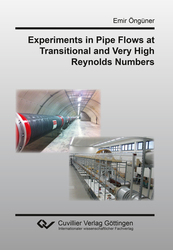| Areas | |
|---|---|
| Serie de libros (96) |
1379
|
| Nachhaltigkeit |
3
|
| Gesundheitswesen |
1
|
| Letra |
2367
|
| Ciencias Naturales |
5407
|
| Ciencias Ingeniería |
1793
|
| Ingeniería | 292 |
| Ingeniería mecánica y de proceso | 862 |
| Ingeniería eléctrica | 686 |
| Mineria y metalurgía | 30 |
| Arquitectura e ingeniería civil | 75 |
| General |
98
|
|
Leitlinien Unfallchirurgie
5. Auflage bestellen |
|
Erweiterte Suche
Experiments in Pipe Flows at Transitional and Very High Reynolds Numbers (Tienda española)
Emir Öngüner (Autor)Previo
Lectura de prueba, PDF (300 KB)
Indice, PDF (32 KB)
The present work aims at investigating the turbulence in pipe flow. Experiments have been performed in two unique pipe facilities: CoLaPipe (CottbusLarge-Pipe) and CICLoPE (Center for International Cooperation in Long Pipe Experiments). The first part of the thesis is focusing on the development of flow considering pressure fluctuations measured along the axial direction to find the location where the flow becomes fully developed turbulent. Results show that application of ring disturbance to the incoming flow initiates turbulence much earlier upstream. The second aim of the thesis is determining the streamwise lengths of large-scale structures in fully developed turbulent state with respect to their wavenumber dependency and spatial correlation using hot-wire anemometry and Particle Image Velocimetry. Meandering structures usually referred as VLSM (very large-scale motions), have been identified with claimed extension up to 20R, where R is the pipe radius. The location of the outer spectral peaks (OSP) which represent the largest energy content per wavenumber outside the viscous wall region is moving towards to the wall as the Reynolds number increases.
| ISBN-13 (Impresion) | 9783736997837 |
| ISBN-13 (E-Book) | 9783736987838 |
| Formato | A5 |
| Idioma | Inglés |
| Numero de paginas | 162 |
| Laminacion de la cubierta | mate |
| Edicion | 1. |
| Lugar de publicacion | Göttingen |
| Lugar de la disertacion | Cottbus-Senftenberg |
| Fecha de publicacion | 02.05.2018 |
| Clasificacion simple | Tesis doctoral |
| Area |
Ingeniería mecánica y de proceso
|
| Palabras claves | Turbulenz, Rohrströmung, hohe Reynoldszahlen, experimentelle Untersuchungen, turbulente Strukturen |








